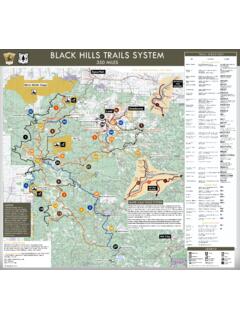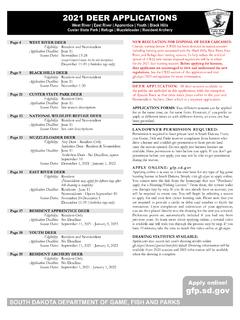Transcription of FISHES OF SOUTH DAKOTA - gfp.sd.gov
1 3 IntroductionSouth DAKOTA is home to more than 100 fi sh species. Included in this guide are tips for identifi cation, distribution maps, and brief life histories of many of these. Also included is a comprehensive listing of all known species in the funding was provided by the SOUTH DAKOTA Department of Game, Fish and Parks through Federal Aid in Sport Fish Restoration Aquatic Education Project 5506 and the SOUTH DAKOTA Cooperative Extension Service through Renewable Resources Extension Act funds. We thank Robert Hanten, Ronald Koth, Charles Scalet, Steve Sammons, and Mark Flamming for technical assistance and review.
2 Issued in furtherance of Cooperative Extension work, Acts of May 8 and June 30, 1914, in cooperation with the USDA. Dr. Barry Dunn, Dean of the College of Agriculture and Biological Sciences and Acting Director of CES, SDSU, Brookings. Educational programs and materials offered without regard to age, race, color, religion, gender, disability, or national 2011 Joseph R. Tomelleri, used by by Forum Communications, May 2011;30,000 copies at a cost of $.42 TO THEFISHES OF SOUTH DAKOTA4 External anatomy of a fi shOpercleLateral line1st dorsal fi n (spines)2nd dorsal fi n (rays)Adipose fi nCaudal fi nAnal fi n (rays)Anal fi n (spines)Pelvic fi nPectoral fi nBarbelsAUTHORSC hristopher W.
3 Hoagstrom Weber State University Ogden, UtahGeno Adams SOUTH DAKOTA Game, Fish and Parks Pierre, SDRobert M. Neumann In-Fisherman Baxter, MNDavid W. Willis SOUTH DAKOTA State University Brookings, SD5 RESOURCESB ooks and articles1.
4 Ashton, D. E and Dowd, E. M. 2006. Fragile legacy: rare animals of SOUTH DAKOTA , second edition. Report No. 91-04, SOUTH DAKOTA Game, Fish & Parks, Pierre, SOUTH Baxter, G. T. and Stone, M. D. 1995. FISHES of Wyoming. Wyoming Game and Fish Department, Cheyenne, Berry, Jr.; Higgins, K. F.; Willis, D. W.; and Chipps, S. R. 2007. History of fi sheries and fi shing in SOUTH DAKOTA . SOUTH DAKOTA Department of Game, Fish, & Parks, Pierre, SOUTH Bosanko, D. 2007. Fish of Minnesota fi eld guide. Adventure Publications, Cambridge, Dickson, T. 2008. The great Minnesota fi sh book. University of Minnesota Press, Minneapolis, Hoagstrom, C.
5 W.; Wall, S. S.; Kral, J. G.; Blackwell, B. G.; and Berry, C. R. Jr. 2007. Zoogeographic patterns and faunal change of SOUTH DAKOTA fi shes. Western North American Naturalist 67 Hoagstrom, C. W.; Hayer, C. A.; Kral, J. G.; Wall, S. S.; and Berry, C. R. Jr. 2006. Rare and declining fi shes of SOUTH DAKOTA : a river drainage scale perspective. Proceedings of the SOUTH DAKOTA Academy of Science 85 Page, L. M. and Burr, B. M. 1991. A fi eld guide to freshwater fi shes: North America north of Mexico. Houghton Miffl in Harcourt, New York, New resources1. Fishing and Boating in SOUTH DAKOTA , shing-boating/2. Threatened & Endangered or Rare Species in SOUTH DAKOTA , Rare FISHES of Eastern SOUTH DAKOTA , sh/rare-fi sh/4.
6 MinnAqua - Fishing Education, Division of Fish & Wildlife Outreach Section, Natural History of Minnesota FISHES , sh/fi North DAKOTA Fish Species, FISHES of Iowa, sh/iafi sh/iafi .. 3 External Anatomy of a Fish .. 4 Quick key to identifying fi shes .. 7 Glossary of Terms .. 10 Sturgeon (family Acipenseridae) .. 12 Paddlefi sh (family Polyodontidae) .. 14 Gar (family Lepisosteidae) .. 15 Mooneye (family Hiodontidae) .. 16 Eel (family Anguillidae) .. 17 Herring (family Clupeidae) .. 18 Minnow (family Cyprinidae) .. 19 Sucker (family Catostomidae) .. 28 Catfi sh (family Ictaluridae) .. 34 Pike (family Esocidae) .. 39 Smelt (family Osmeridae).
7 41 Trout (family Salmonidae) .. 42 Cod (family Gadidae) .. 47 Stickleback (family Gasterosteidae) .. 48 Temperate bass (family Moronidae) .. 49 Sunfi sh (family Centrarchidae) .. 50 Perch (family Percidae) .. 59 Drum (family Sciaenidae).. 64 Fish species found in SOUTH DAKOTA .. 65 Species index .. 707 QUICK KEY TO IDENTIFYING FISHESEach of the following categories provides a quick means to rule out many common fi shes in an attempt to identify a specifi c fi sh. Each illustrated fi sh in the following species accounts is grouped within each of the categories described TYPE: distinct types of fi shes can be found in different types of habitats commonly distinguished by water temperature.
8 The location from which the fi sh you wish to identify was collected can be an important clue to the type of fi Cold-water habitat: water body in which year-round temperature is usually below 65o F (18o C). In SOUTH DAKOTA , this includes high-elevation streams of the Black Hills, deep-water habitats in lakes and impoundments, and tailwater reaches of streams below dams that discharge water from the bottom of the water Cool-water habitat: water body in which year-round temperature is usually below 75o F (24o C) and temperature fl uctuation is minor. In SOUTH DAKOTA , this includes spring-fed streams that ring the Black Hills as well as spring-fed lakes and streams present throughout the state, including those along escarpments such as the Missouri River Bluffs, the Missouri Couteau, and the Prairie Warm-water habitat: water body in which temperature may fl uctuate dramatically throughout the year and in which temperatures often exceed 75o F (24o C) during summer.
9 Most water bodies of SOUTH TYPE: fi shes with unique types of scales are readily distinguished from fi sh with more typical Large, shiny (silvery), deciduous scales: fi shes typically present in clear, open-water habitats such as lakes and cool-water streams may have this type of scale. Illustrated examples: gizzard shad, goldeye, and common Small, colored, non-deciduous scales: most types of fi shes have this type of scale. Color and size are highly variable within and among species. Most fi shes of SOUTH DAKOTA have this type of Scale armor: leathery, rectangular or diamond-shaped scales create a suit of armor that covers the entire body of the fi sh.
10 Illustrated example: shortnose Scaleless (no visible scales): fi shes entirely lacking scales have a smooth skin. Illustrated examples: sturgeons, paddlefi sh, American eel, burbot, and brook TYPE: (refer to image on page 4) fi shes with barbels are relatively easily distinguished from those Long snout, mouth, and chin barbels: Illustrated examples: catfi Long chin barbels only: Illustrated examples: sturgeons, Moderate-sized mouth barbels only: barbels in the corner of the mouth (where the upper and lower jaws unite). Illustrated examples: common carp, fl athead Inconspicuous mouth barbels: in or near the corner of the mouth (where the upper and lower jaws unite), but diffi cult to see without magnifi cation.














